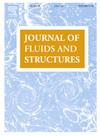在水中行走时腿部周围流动的数值模拟及其对水疗运动的影响
IF 3.5
2区 工程技术
Q1 ENGINEERING, MECHANICAL
引用次数: 0
摘要
一种常见的水疗运动是在水中行走,因为浮力可以减少关节负荷,增加病人的活动能力。流体阻力(流体作用于人的力,方向与运动方向相反)会引起肌肉激活的变化,就像在水中行走与在地上行走相比,会改变作用在腿上的力一样。在这里,通过一系列的数值模拟,我们量化了由于腿部在水中运动而作用在腿部上的水流力如何在步行步态周期中发生变化。我们表明,除了作用在行走腿上的阻力,当腿向前加速时达到峰值,相对较大的横向力(垂直于运动方向的方向)也作用在腿上。这些力是由两条腿靠近时另一条腿的快速加速引起的,在腿周围产生不对称的压力分布。这些结果是出乎意料的,可以为设计患者的水治疗计划提供重要的意义,通过考虑在水中行走时作用于身体的阻力之外的侧向力。本文章由计算机程序翻译,如有差异,请以英文原文为准。
Numerical simulation of flow around the legs during walking in water with implications for hydrotherapeutic exercise
One of the common hydrotherapeutic exercises is walking in water because buoyancy reduces joint loading and increases mobility for a patient. The fluid drag forces (the forces that act on the person from the fluid in the direction opposing the direction of motion) cause changes in muscle activations, as walking in water changes the forces that act on the leg compared with overground walking. Here, through a series of numerical simulations, we quantify how the flow forces that act on the leg due to its motion in water change over a walking gait cycle. We show that besides drag forces that act on the walking legs and peak when the leg is accelerated forward, relatively large lateral forces (in the direction perpendicular to the direction of motion) also act on the leg. These forces are caused by the rapid acceleration of the opposite leg when the two legs are close, creating an asymmetric pressure distribution around the leg. These results are unexpected and could have significant implications for designing hydrotherapeutic plans for patients by considering the lateral forces besides the drag forces that act on the body while walking in water.
求助全文
通过发布文献求助,成功后即可免费获取论文全文。
去求助
来源期刊

Journal of Fluids and Structures
工程技术-工程:机械
CiteScore
6.90
自引率
8.30%
发文量
173
审稿时长
65 days
期刊介绍:
The Journal of Fluids and Structures serves as a focal point and a forum for the exchange of ideas, for the many kinds of specialists and practitioners concerned with fluid–structure interactions and the dynamics of systems related thereto, in any field. One of its aims is to foster the cross–fertilization of ideas, methods and techniques in the various disciplines involved.
The journal publishes papers that present original and significant contributions on all aspects of the mechanical interactions between fluids and solids, regardless of scale.
 求助内容:
求助内容: 应助结果提醒方式:
应助结果提醒方式:


